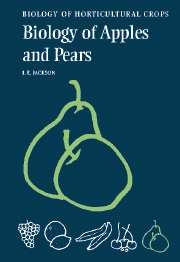Book contents
- Frontmatter
- Contents
- Preface
- Acknowledgements
- Introduction
- 1 The growing of apples and pears
- 2 Apples and pears and their relatives
- 3 Apple and pear root systems: induction, development, structure and function
- 4 The graft union, grafting and budding
- 5 Mechanisms of rootstock and interstock effects on scion vigour
- 6 The shoot system
- 7 Leaves, canopies and light interception
- 8 Photosynthesis, respiration, and carbohydrate transport, partitioning and storage
- 9 Flowers and fruits
- 10 Eating quality and its retention
- 11 Mineral nutrition
- 12 Water relations
- 13 Diseases, pests, and resistance to these
- 14 Biotechnology of apples and pears
- Cultivar Index
- General Index
- References
4 - The graft union, grafting and budding
Published online by Cambridge University Press: 13 August 2009
- Frontmatter
- Contents
- Preface
- Acknowledgements
- Introduction
- 1 The growing of apples and pears
- 2 Apples and pears and their relatives
- 3 Apple and pear root systems: induction, development, structure and function
- 4 The graft union, grafting and budding
- 5 Mechanisms of rootstock and interstock effects on scion vigour
- 6 The shoot system
- 7 Leaves, canopies and light interception
- 8 Photosynthesis, respiration, and carbohydrate transport, partitioning and storage
- 9 Flowers and fruits
- 10 Eating quality and its retention
- 11 Mineral nutrition
- 12 Water relations
- 13 Diseases, pests, and resistance to these
- 14 Biotechnology of apples and pears
- Cultivar Index
- General Index
- References
Summary
Introduction
Grafting is the art of connecting two pieces of living tissue together in such a way that they unite and grow as one. In apples and pears it is generally used to combine a scion (fruiting) cultivar with a rootstock. Budding is a special form of grafting in which the initial scionwood component is reduced to a single bud.
This art has been practised for thousands of years, Garner (1988) noting that grafting with detached scions was used by the Chinese before 2000 BC. It was described by writers in ancient Greece and Rome and very widely employed in western Europe in the Renaissance period and subsequently.
The main purposes of grafting are to assist in the propagation and perpetuation of clones that cannot readily be propagated by other asexual means, and to enable the production of composite trees from rootstocks and scions each of which possesses specific and distinct desirable attributes. It is also used to change scion cultivars in established orchards, to hasten the fruiting of seedling selections in breeding programmes and as a research tool in the study of physiological processes and viruses.
Formation of the graft union
The formation of the graft union can be considered as resulting from the wound-healing processes which take place on the cut surfaces of the rootstock and scion, operating in the context of close contact between surfaces. The union is accomplished entirely by cells that develop after the grafting operation. The sequence of events is as follows.
- Type
- Chapter
- Information
- The Biology of Apples and Pears , pp. 126 - 140Publisher: Cambridge University PressPrint publication year: 2003



